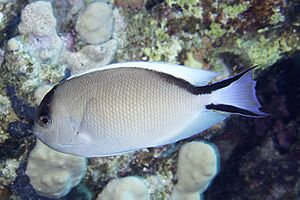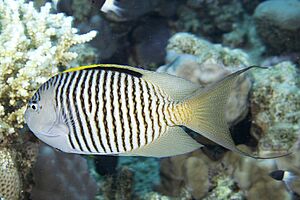Zebra angelfish facts for kids
Quick facts for kids Zebra angelfish |
|
|---|---|
 |
|
| Female specimen | |
| Conservation status | |
| Scientific classification | |
| Synonyms | |
|
The Genicanthus caudovittatus, often called the zebra angelfish, is a beautiful fish that lives in the ocean. It's also known as the swallowtail angelfish or lyretail angelfish. This fish is a type of marine angelfish and belongs to the family called Pomacanthidae. You can find these colorful fish swimming in the Indian Ocean.
Contents
What Does the Zebra Angelfish Look Like?
Zebra angelfish are special because the males and females look very different. This is called sexual dichromatism. It means they have different colors and patterns.
Male zebra angelfish are whitish-blue. They have dark brown stripes going up and down their bodies. They also have a black stripe along the middle of their top fin, called the dorsal fin.
Female zebra angelfish are a pale pinkish-grey color. They have a black stripe across their eye. They also have black stripes on the top and bottom edges of their tail fin.
Both male and female zebra angelfish have a tail fin that is deeply forked, like a "V" shape. This is why they are sometimes called "lyretail" or "swallowtail" angelfish. These fish can grow up to 20 centimeters (about 8 inches) long.
Where Do Zebra Angelfish Live?
The zebra angelfish lives in the western part of the Indian Ocean. You can find them along the eastern coast of Africa. This includes places like the Red Sea in the north and KwaZulu-Natal in South Africa.
They also live further east in places like Madagascar, Maldives, Mauritius, and Réunion. They have even been seen near Weh Island off the coast of Sumatra.
Habitat and Daily Life
Zebra angelfish usually live in water that is 15 to 70 meters (about 50 to 230 feet) deep. In some areas, like the Red Sea, they can be found in shallower water.
They like to live on steep outer parts of coral reefs. These are places where the reef drops off into deeper water. They often live in small groups. Each group usually has one male and a few females.
These fish eat tiny living things called plankton. Plankton float in the water and are a common food source for many ocean animals. Young zebra angelfish, called juveniles, tend to live in deeper water than the adult fish.
How the Zebra Angelfish Got Its Name
The zebra angelfish was first officially described in 1860. It was named Holocanthus caudovittatus by a scientist named Albert Günther. He was a German-born British expert on fish and reptiles.
The name caudovittatus comes from two words. Caudus means "tail," and vittatus means "banded." This name refers to the black stripes found on the tail of the fish.
Zebra Angelfish in Aquariums
Sometimes, the zebra angelfish is caught and sold for aquariums. People who love keeping marine fish might have them in their home tanks.



